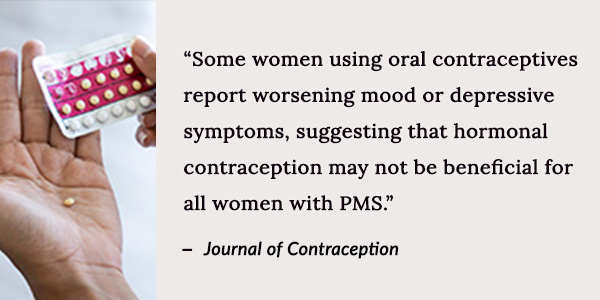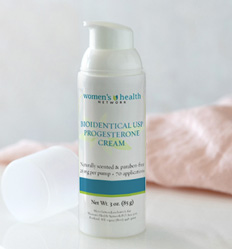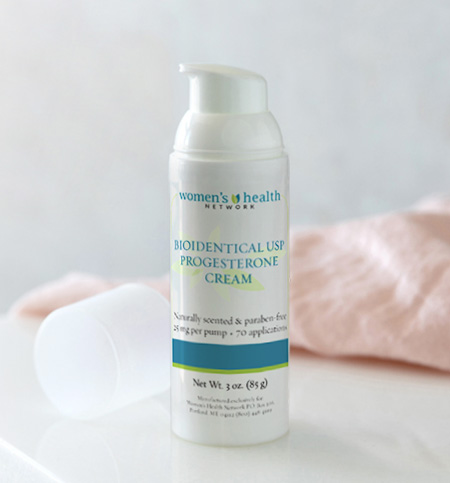Authored by Dr. Sarika Arora, MD
Some women experience such terrible PMS (premenstrual syndrome) that it completely devastates their lives. Many need advanced treatments for PMS to get relief from their symptoms and feel normal again.

Your symptoms may not be fully responding to the steps we’ve previously outlined. Or, you may have a diagnosis of PMS or PMDD and your symptoms are severe and entrenched. If either of these describe you, consider the following advanced treatments.
In most cases, these advanced strategies are needed on a temporary basis only. That could be anywhere from a few months to a few years. Then the idea is that as the body naturally begins to function more normally, physical and emotional symptoms smooth out. And the more potent therapies can be tapered off.
Note that you will need the guidance of a qualified healthcare practitioner to pursue these options.
Natural neurotransmitter treatments for PMS
For those women who are still symptomatic after boosting their nutritional support, making dietary changes, improving exercise habits and using bioidentical progesterone support, we often consider more focused natural neurotransmitter treatments for PMS. Some options for targeting neurotransmitter function include the following:
- Additional omega–3 fatty acids in the form of EPA/DHA, boosting to 2–3 grams per day total.
- 5–HTP, 50–100 mg, generally taken in the evening. More may be needed during the PMS time-frame (up to 800 mg). But dosage and timing depend on your body’s individual make-up.
- Vitamin D (25-OH Vitamin D) blood testing and supplemental treatment to achieve optimal blood levels (50–60 ng/mL).
- A trial of St. John’s wort, dosage and formulation varying with the individual. And not to be taken in conjunction with prescription antidepressants.
- Neurotransmitter testing: evaluating levels of serotonin, dopamine, norepinephrine and GABA levels, as well as others, to gain an overall sense of what levels are.
- Neurologic support with amino acid and herbal combination formulas.
Prescription-dose bioidentical progesterone for PMS and PMDD
Some women with severe PMS may want to ask their healthcare provider about trying higher dose prescription-strength progesterone treatments. It is also an excellent alternative for women who prefer to avoid using birth control pills or antidepressants for PMS or PMDD, or those who cannot tolerate their side effects.
You can choose between brand name formulas, such as Prometrium, or custom-compounded USP (bioidentical) progesterone from specialty pharmacies. This is not currently an FDA-approved use of Prometrium. It is considered “off-label” use, so your healthcare provider has to be comfortable with this method. If a woman is at an age where we suspect chronic progesterone deficiency, we may have her use it longer term as well (until menopause). It can help address underlying causes of problems other than PMS that are associated with low progesterone, such as irregular periods and heavy bleeding.
In any event, it’s a good idea for you to have your baseline progesterone levels tested. This may even reveal overt luteal phase progesterone deficiency to support the premise behind this approach. In fact, when progesterone is the issue behind a woman’s symptoms, supplemental progesterone can be miraculous for her. Yet the range of normal is so wide it can be difficult for less experienced practitioners to interpret what is low for an individual.
Note that women taking oral bioidentical progesterone should have their levels checked every three to six months. But we will check levels of all the hormones to make sure progesterone is not being converted into estrogen.
Where the conventional approach falls short — prescription antidepressant treatments for PMS and PMDD
The possibility of a cyclical neurotransmitter balance is why the first stop for many conventional practitioners treating patients with PMS and PMDD is antidepressants. At Women’s Health Network, we strongly encourage women to try a number of highly effective first-line natural treatments for PMS that can naturally restore neurotransmitter balance before signing on to synthetic designer drugs for PMS, whether antidepressants or birth control pills, particularly if their symptoms are mild or moderate.
Neurotransmitters are built from amino acids, and amino acids are found in proper nutrition and can be naturally supplemented. If a woman’s neurotransmitters are off premenstrually, taking cyclic antidepressants may have a temporary effect on her mood swings. But it will not heal her physiology. It is altogether too common for us to see patients who have been drowning out their bodies’ signals with prescription antidepressants. These drugs may help get rid of the symptoms in the short-term, but do nothing to encourage the body to resume control of its internal balancing mechanisms. In the long-term, these medications don’t work; in fact, they may even make the situation worse.
Moreover, as common as premenstrual symptoms are, each woman has her own PMS-inducing stressors. So it makes little sense to treat everyone with identical synthetic drug formulas. So instead of opting for the pharmaceutical option first, think of the bigger picture and start with the basics by learning to understand the causes of PMS and PMDD.
Antidepressant treatments for PMS and PMDD — serotonin stop-gaps
In extremely severe cases where a woman simply cannot get herself out of bed, or becomes unsafe to herself or others when premenstrual, antidepressants serve as a last resort. SSRI medications such as Sarafem are often used in these situations. In addition to Sarafem for PMDD, other antidepressants commonly prescribed as PMS treatments include Zoloft, Lexapro, Effexor and Wellbutrin. However, without a thorough investigation of a woman’s individual health picture, it can be hard for many conventional practitioners to determine whether the patient has underlying dysthymia (a milder form of chronic depression) or another depressive disorder.
Before turning to an antidepressant for “rescue,” we encourage you to investigate your symptoms fully with a trusted healthcare practitioner and/or a mental health specialist. You need time and a safe place to tell your story. Along with helping you and your provider gain a more accurate picture of your mental and physical health, this process can help you heal. If a woman still feels that she needs emergency support, I generally acquiesce. But only under the close guidance and monitoring of a healthcare provider skilled in advanced implementation of these medications.
Combine with natural solutions
Of course, I always encourage any woman to continue trying to improve her nutrition and lifestyle choices while on these medications. If you opt to use Sarafem for PMDD or PMS, consider a compromise approach with a trial of bioidentical progesterone or targeted neurotransmitter support as well. These can help to replete your neurotransmitters naturally.
Some women are just beginning to navigate their health issues. And they are unwilling or unable to adopt a more natural approach — fundamental nutritional and lifestyle changes or advanced measures — for whatever reason. For such a woman, antidepressant medication can serve as a bridge over troubled waters, motivating her to begin making more positive changes. From there, we hope she can adopt more holistic treatments for PMS until she feels well and strong enough to wean from her medication.
NOTE OF CAUTION: If you are on prescription antidepressants or mood stabilizing medications, consult your prescribing doctor before making any changes in your medications. These medications cause a change in your body chemistry. Some individuals experience severe symptoms, including anxiety, chest pain and headaches, if these medications are abruptly stopped. Nevertheless, you can always consider adding fundamental nutritional and lifestyle support measures to enhance your progress. If you order our PMS Package for additional support, please be sure to schedule an appointment with our Nurse–Educators for further guidance as well.
How birth control pills obliviate your PMS and menstruation
For some women who need contraception and want the birth control pill, this ameliorates their symptoms of PMS. But this is principally because the synthetic hormones in the Pill stop your body from ovulating. It can also make some women feel worse. Using oral contraceptives to inhibit ovulation seems to tamp down some of the symptoms of hormonal imbalance that occur in the second half of the cycle for a PMS person. We respect this choice some women make, but urge them to take on nutritional support and healthy lifestyle choices as well.
Currently popular choices include the third-generation lower-estrogen pills such as Ortho Tri-Cyclen, Ortho Try-Cyclen Lo, Mircette and their various generic forms, as well as the NuvaRing vaginal delivery method. The new Yasmin pill and lower dose Yaz have been shown in studies to have a significant impact on mood and physical symptoms. This has lead to their heavy marketing toward PMS and PMDD sufferers.
Again, while birth control pills are popular as a form of contraception, we see their use for treating a range of women’s health issues, such as irregular cycles, acne and symptoms of PMS, as palliative only. This means they relieve the symptoms without effecting a cure. This is not a solution that fully serves you because it cannot resolve the core imbalances that underlie these issues. Nor can antidepressant medications. The benefits of these medications are temporary at best.
What does “PMS” stand for?
We hope you will consider your individual health picture and learn what severe PMS stands for in your life. We wholeheartedly feel that every woman with premenstrual syndrome can learn to transform “the curse” into a blessing. Embrace the measures that create a foundation of health — not just for the reproductive years, but the perimenopausal transition and well beyond. And we’re here to help each step of the way.












